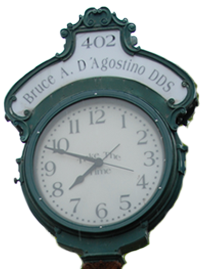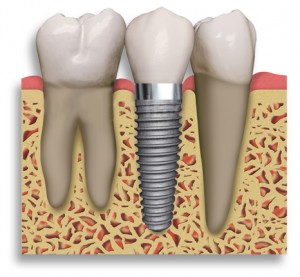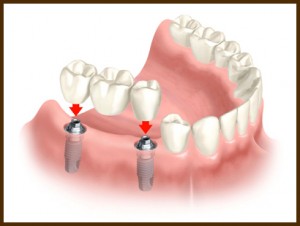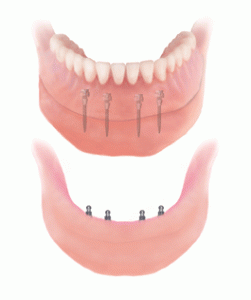Implant Resources
Does a missing tooth, or teeth, make you feel self consious? Do you want to avoid losing good tooth structure for a bridge? Then a dental implant may be the option for you. These resources may give you a better idea of what implants are all about.
What do dental implants look like?
Dental implants can look just like a natural tooth. here are some examples on the results:
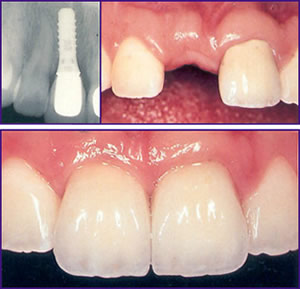 Dental Implant-Before and After
Dental Implant-Before and After
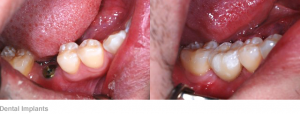 A dental implant during the healing stage, and after crown placement
A dental implant during the healing stage, and after crown placement
The ideal candidate for a dental implant is in good general and oral health. Adequate bone in your jaw is needed to support the implant, and the best candidates have healthy gum tissues that are free of periodontal disease.
Dental implants are intimately connected with the gum tissues and underlying bone in the mouth. There are many things that can affect the health of your mouth, and therefore, may affect the success of an implant.
- Smoking, or even a history of smoking can decrease the success rate of dental implants.
- Diabetes that is not well controlled can make it more difficult to heal after any surgery, especially one involving a dental implant.
- Active periodontal disease ( that is not being treated and monitored by our Doctors and Hygienists) can also decrease the success of an implant.
These along with other chronic health problems may be a concern for placing a dental implant. Dr. Bruce and Dr. Adrienne would be happy to discuss with you further if you are a good candidate for a dental implant.
What are the implant options?
This procedure is a team effort between you, Dr. Bruce and Dr. Adrienne, and sometimes, if neccessary, a specialist. Dr. Bruce or Dr. Adrienne will consult with you to determine where and how your implant should be placed. Depending on your specific condition and the type of implant chosen, we will create a treatment plan tailored to meet your needs.
- Replacing a single tooth: If you are missing a single tooth, one implant and a crown can replace it.
- Replacing several teeth: If you are missing several teeth, implant-supported bridges may be the right choice to replace them
- Replacing all of your teeth If you are missing all of your teeth, an implant-supported full bridge or full denture may be the option to replace them.
Possible additional needs
- Sinus Augmentation: A key to implant success is the quantity and quality of the bone where the implant is to be placed. The upper back jaw has traditionally been one of the most difficult areas to successfully place dental implants due to insufficient bone quantity and quality and the close proximity to the sinus. Sinus augmentation can help correct this problem by raising the sinus floor and developing bone for the placement of dental implants.
- Ridge modification: Deformities in thejaw can leave you with inadequate bone in which to place dental implants. To correct the problem, the gum is lifted away from the ridge to expose the bony defect. The defect is then filled with bone or bone substitute to build up the ridge. Ridge modification has been shown to greatly improve appearance and increase your chances for successful implants that can last for years to come.
Steps to receiving an Implant
- First, the implant will be surgically placed into the jawbone. a diet of soft foods, cold foods and warm soup during the healing process may be advised to avoid damaging the post during the healing process.
- Next, the bone around the implant heals in a process called osseointegration. What makes an implant so strong is that the bone actually grows around it and holds it in place. Osseointegration means “combines with the bone” and takes time. Some patients might need to wait until the implant is completely integrated, sometimes up to 6 months or longer, before replacement teeth can be attached to the implant. Other patients can have the implants and replacement teeth placed all in one visit.
- lastly, it’s time for the placement of the artificial tooth/teeth. Your new tooth will be customized for you, called a dental crown. The crown will be based on size, shape, color and fit, and will be designed to blend naturally with your other teeth. If you are replacing more than a single tooth, custom-made bridges or dentures may be made to fit your mouth and your implants. (Note: The replacement teeth usually take some time to make. In the meantime, we may give you a temporary crown, bridge or denture to help you eat and speak normally until the permanent replacement is ready.)
What can I expect after the placement of a dental implant?
As you know, your own teeth require conscientious at-home oral care and regular dental visits. Dental implants are like your own teeth and will require the same care. In order to keep your implant clean and plaque-free, brushing, flossing and regular preventive dental cleaning visits still apply!
After treatment, Dr. Bruce and Dr. Adrienne will work with you to establish the best care plan for you. Periodic follow-up visits will be scheduled to monitor your implant, teeth and gums to make sure they are healthy.

